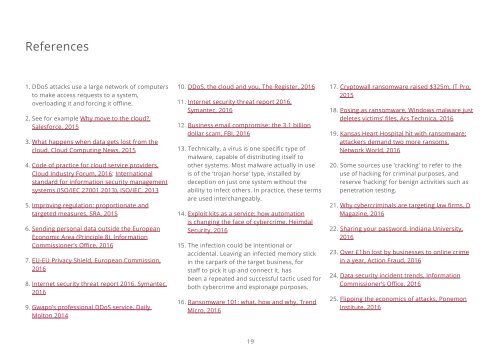IT security
it-security
it-security
You also want an ePaper? Increase the reach of your titles
YUMPU automatically turns print PDFs into web optimized ePapers that Google loves.
References<br />
1. DDoS attacks use a large network of computers<br />
to make access requests to a system,<br />
overloading it and forcing it offline.<br />
2. See for example Why move to the cloud?,<br />
Salesforce, 2015<br />
3. What happens when data gets lost from the<br />
cloud, Cloud Computing News, 2015<br />
4. Code of practice for cloud service providers,<br />
Cloud Industry Forum, 2016; International<br />
standard for information <strong>security</strong> management<br />
systems (ISO/IEC 27001 2013), ISO/IEC, 2013<br />
5. Improving regulation: proportionate and<br />
targeted measures, SRA, 2015<br />
6. Sending personal data outside the European<br />
Economic Area (Principle 8), Information<br />
Commissioner’s Office, 2016<br />
7. EU-EU Privacy Shield, European Commission,<br />
2016<br />
8. Internet <strong>security</strong> threat report 2016, Symantec,<br />
2016<br />
9.<br />
Gwapo’s professional DDoS service, Daily<br />
Molton 2014<br />
10. DDoS, the cloud and you, The Register, 2016<br />
11. Internet <strong>security</strong> threat report 2016,<br />
Symantec, 2016<br />
12. Business email compromise: the 3.1 billion<br />
dollar scam, FBI, 2016<br />
13. Technically, a virus is one specific type of<br />
malware, capable of distributing itself to<br />
other systems. Most malware actually in use<br />
is of the ‘trojan horse’ type, installed by<br />
deception on just one system without the<br />
ability to infect others. In practice, these terms<br />
are used interchangeably.<br />
14. Exploit kits as a service: how automation<br />
is changing the face of cybercrime, Heimdal<br />
Security, 2016<br />
15. The infection could be intentional or<br />
accidental. Leaving an infected memory stick<br />
in the carpark of the target business, for<br />
staff to pick it up and connect it, has<br />
been a repeated and successful tactic used for<br />
both cybercrime and espionage purposes.<br />
16. Ransomware 101: what, how and why, Trend<br />
Micro, 2016<br />
17. Cryptowall ransomware raised $325m, <strong>IT</strong> Pro,<br />
2015<br />
18. Posing as ransomware, Windows malware just<br />
deletes victims’ files, Ars Technica, 2016<br />
19. Kansas Heart Hospital hit with ransomware:<br />
attackers demand two more ransoms,<br />
Network World, 2016<br />
20. Some sources use ‘cracking’ to refer to the<br />
use of hacking for criminal purposes, and<br />
reserve ‘hacking’ for benign activities such as<br />
penetration testing.<br />
21. Why cybercriminals are targeting law firms, D<br />
Magazine, 2016<br />
22. Sharing your password, Indiana University,<br />
2016<br />
23. Over £1bn lost by businesses to online crime<br />
in a year, Action Fraud, 2016<br />
24. Data <strong>security</strong> incident trends, Information<br />
Commissioner’s Office, 2016<br />
25. Flipping the economics of attacks, Ponemon<br />
Institute, 2016<br />
19


